HORDERN HOUSE
RARE BOOKS · MANUSCRIPTS · PAINT INGS
Voyages & Natural History

FIRST SWEDISH EDITION
1. BLIGH, William.
Capitainens vid Engelske Ammiralitetet, Wiliam Bligh’s Resa…
Small octavo, woodcut headpiece; in understated contemporary half calf. Nyköping, Joh. Pet. Hammarin, 1795.
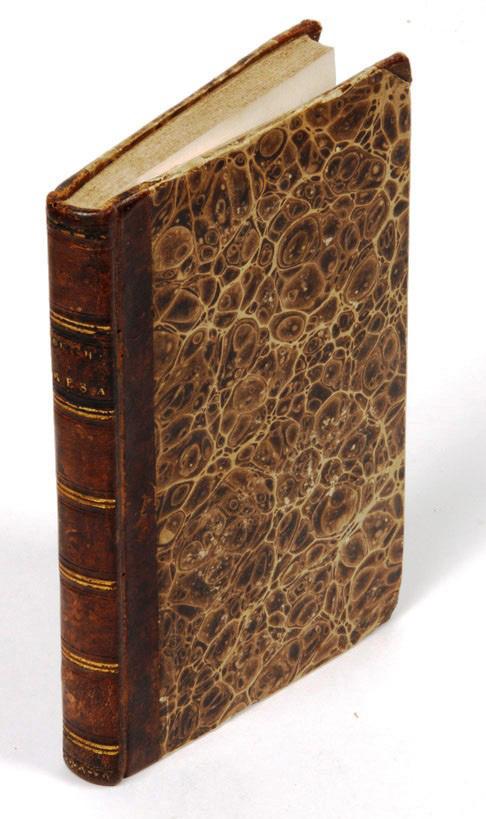
First Swedish edition of Bligh’s Voyage to the South Seas.
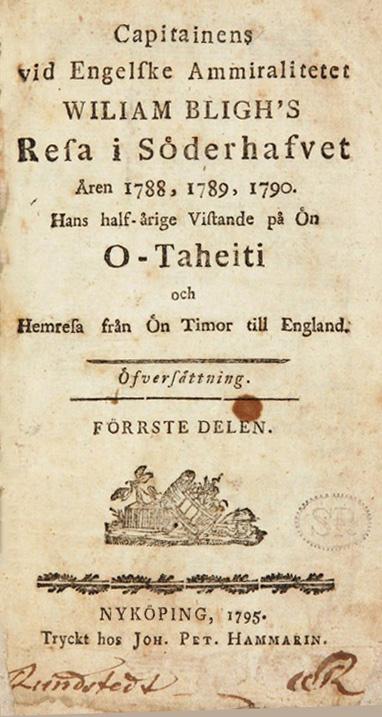
Rolf du Rietz’s excellent note in the catalogue of the Kroepelien catalogue explains that this very rare version was anonymously translated by Carl Fr. Landell from Georg Forster’s German edition of the Bligh account, and includes Forster’s introduction. As with the German edition on which it is based, this book only includes the new material from the 1792 Voyage: that is, none of the Narrative section is included here, and a footnote explains that Ödmann’s Swedish translation of that part should be thought of as the “second volume”, so-called. This explains, in passing, the otherwise rather cryptic “Förrste Delen” (“first part”) noted on the title-page here. Such a publishing arrangement had been Bligh’s original intention for the English edition, but he considered that some sections of the Narrative should be revised for republication.
Ferguson noted only the Mitchell copy and another in the Kroepelien collection.+
Ferguson, 216; Kroepelien, 96; not in Hill; not in Spence; O’Reilly-Reitman, 556a.
$3800 [3902031 at hordern.com]
see description and illustrations at
HOUSE hordern.com
HORDERN
PIONEER WORK ON THE BOTANY OF AUSTRALIA AND THE SOUTH PACIFIC

2. [COOK: SECOND VOYAGE] FORSTER, Johann Reinhold and Georg.
Characteres Generum Plantarum…
Quarto, with 78 engraved plates (numbered 1-75 and including 38a & b & 51a); contemporary mottled calf, spine decorated and lettered in gilt in compartments between raised bands, marbled endpapers and red edges, a fine copy. London, B. White, T. Cadell & P. Elmsly, 1776.
First edition: one of two contemporary issues, probably the first, with the longer dedication to George III. This was the first scientific work – in fact one of the earliest publications of any kind – published as a result of Cook’s second voyage. The Forsters, father and son, travelled as scientists on the second voyage, and took on Anders Sparrman as their assistant at the Cape of Good Hope in 1772. The book is a Linnean classification of botanical discoveries made during the voyage; the descriptions are by Sparrman and the engravings are after drawings by the younger Forster. As one of the earliest sources for our knowledge of the plants of Australasia and Polynesia, it represents the foundation work for New Zealand, Australian Antarctic and Polynesian botany.
As well as being one of a surprisingly small number of monuments to the major scientific achievements of Cook’s voyages, the Characteres was one of the earliest publications resulting from the second voyage; the previous year Marra’s surreptitious narrative had been published, while in 1776 only this and the anonymous Second Voyage round the World appeared. In 1777 both the Forsters’ narrative and the official account by Cook were published, along with Wales’ and Bayly’s Astronomical Observations, followed a year later by the Forsters’ Observations. The rush to get it into print should probably be seen in the light of the quarrel with the Admiralty over the Forsters’ claims to publishing rights for the official account of the voyage. This pre-emptive scientific publication may well have been intended to show the strength of the Forster camp.
Cook’s second voyage generated an enormous collection of new genera and species: “This work is botanically important as containing a large number of new generic and specific names relating to plants of Australia and Polynesia. It appears that in the preparation of this undertaking the Forsters were able to use the fine natural history library belonging to Sir Joseph Banks, and to seek the advice of his librarian Daniel Solander. Furthermore, they had free access to Banks and Solander’s collections made on Cook’s first voyage (1768-71) to the Pacific, and to Solander’s manuscripts’ (Henrey II, p. 167).
Beddie, 1385; Hill, 627; Holmes, 17; Hunt 649; Nissen, BBI, 644; Pritzel, 2981; Rosove, 139.A1 (“very scarce”).
$14,000 [5000281 at hordern.com] see description and illustrations at
HORDERN HOUSE hordern.com
THE SUPERB OFFICIAL NARRATIVE OF COOK’S THIRD VOYAGE
3. [COOK: THIRD VOYAGE] COOK, James and James KING.
A Voyage to the Pacific Ocean…
Three volumes, quarto, and an atlas, folio, with altogether 87 engraved plates and maps, of which 63 appear in the atlas; contemporary diced russia leather, flat spines gilt in compartments with a complex design, black leather lettering pieces and round crimson numberingpieces within dark green labels; the atlas volume in a neat modern binding of half calf and marbled boards. London, Printed by W. and A. Strahan, for G. Nicol… and T. Cadell, 1784.

First edition of the official account of Cook’s last voyage. This is a good set of this tremendous publication, the detailed narrative of the voyage extensively illustrated with beautiful engravings after John Webber, and so popular at the time that copies were sometimes literally read to pieces. “A magnificent summation of all the public and private journals, logs, drawings and other observations made during the voyage, and… as important a record of the exploration of the North Pacific as Cook’s first two voyages had been for the South Pacific. It is in fact one of the most important English books published in the last quarter of the eighteenth century…” (Forbes).
The Resolution and Discovery made an enormous sweep throughout the Pacific, calling at Tasmania, New Zealand, the Cook Islands, Tonga and Tahiti before heading north and making famous landfall at the Hawaiian islands, which Cook named the Sandwich Islands in honour of his patron. After exploring the Northwest coast of America and returning to Hawaii, Cook was killed in the notorious skirmish ashore. Command passed to Clerke, and, after his death, to John Gore. The shocking news of the explorer’s death reached England through overland reports from the Russian Pacific coast some months before the ships themselves returned. It marked the end of an age, and the beginning of another that would feature a number of the men who had been aboard the Cook voyage: among them Bligh, Vancouver, and Colnett.
Unlike the official narratives of the first two Cook voyages, this was planned as a grander publication with the three text volumes containing some of the lesser illustrations but the 63 more important illustrations and maps appearing on a large scale in the separate folio-sized atlas volume. The result does justice to John Webber’s superb visualisations of the Pacific. Webber was the official artist on the voyage: his romantic views remain the most evocative of all early portrayals of the islands, and helped to foster the notion of island paradise that so affected an European public eagerly reading the voyages of discovery being published in the eighteenth century.
The full story of the voyage, including the narrative of Cook’s murder at Kealakekua Bay, was so eagerly awaited by the public that the entire first edition sold out within three days, at the then huge price of four pounds fourteen shillings and sixpence, and copies were soon changing hands at up to ten guineas.
Beddie, 1552; Forbes, ‘Hawaiian National Bibliography’, 85; Hawaii One Hundred, 5; Hill, 361; O’Reilly-Reitman, 434.
Provenance: Robert Baker (early signature in volume 1), possibly the Baker whose books were sold by Sotheby in 1855 and whose copy of the Cook second voyage atlas is in the Dixson Library, State Library of New South Wales; H. Mackenzie-Begg, with his small bookplate in each volume.
$18,500 [4401862 at hordern.com]
see description and illustrations at
HORDERN HOUSE hordern.com
NAVAL SHANTIES
4. DIBDIN, Charles.
The Sea Songs of Charles Dibdin…
Tall quarto, copperplate engraved music and text; contemporary half calf, a very handsome copy, the spine gilt and with an unusual triple “harlequin” set of labels in red, white & blue. London, G. and W.B. Whittaker, 1823.
First edition of this early collection of the patriotic ditties and rollicking shanties of the British navy: a fascinating and important record of the conditions of the Georgian sailor. Many of the songs had a lasting influence on the spirit of the navy, especially during the protracted war with France. Each is present in an engraved musical score with lyrics.

The collection was put together by the prolific Charles Dibdin (1745-1815). His son Thomas, in a brief biographical notice appended to the 1850 collective edition of his father’s sea-songs, remarked: ‘These songs have been the solace of sailors in long voyages, in storms, in battles; and they have been quoted in mutinies to the restoration of order and discipline’. Readers may be surprised to learn that many take “Grog” or trouncing the French as their theme.
Bringing out his first two-act opera when he was only sixteen, Dibdin had a long career as an actor and singer, and worked briefly with David Garrick. A seemingly inexhaustible writer, he composed some one thousand songs during his career and was also a sometime playwright, self-publishing Great News or A Trip to the Antipodes in 1794. For a complete list of the dramatist-composer’s published and unpublished plays, musical entertainments and compositions see E.R. Dibdin, A Dibdin Bibliography (Liverpool, 1937). Dibdin was not much of a sailor himself: in 1788 he sailed for the East Indies, but bad weather forced the ship back to port at Torbay. He took it as a sign and returned to London.
This book neatly demonstrates the difficulty of producing a book with a letterpress introduction and engraved plates throughout: several numbers are omitted from the series and, conversely, three listed songs are not included. This is, nonetheless, the standard collation of the book with ninety-five (rather than ninety-nine) songs.
$2250 [3702877 at hordern.com] see description and illustrations at
HORDERN HOUSE hordern.com
THE CHANCE DISCOVERIES THAT SOLVED THE 40-YEAR MYSTERY
5. DILLON, Peter.
Narrative and Successful Result of a Voyage in the South Seas…
Two volumes, octavo, plates (two folding, one coloured), and a folding map; plates crisp, in half green morocco by Sangorski & Sutcliffe, spine banded and gilt. London, Hurst, Chance and Co., 1829.
First edition: the solution of the La Pérouse mystery.
Forty years after the French explorer first disappeared, Peter Dillon, a sandalwood trader, called at the Solomons; when a silver sword guard was shown to him, he suspected that he might have accidentally discovered the solution of a mystery that had tormented the French for so long. He returned to India and persuaded the government of Bengal to sponsor an expedition. At Vanikoro he found many relics including a portion of the stern of the Boussole, ships’ bells stamped ‘Bazin m’a fait’, monogrammed silver, metal fragments and mill stones known to have been aboard. One native had a glass piece from a thermometer in his nose. Dillon was made a Chevalier of the Legion d’Honneur, his expenses defrayed and granted a pension. His book was commercially successful, appearing in English and French editions promptly and eventually in a number of translations.
Although Captain Peter Dillon is best known for his role in finding the wreck of La Pérouse’s two vessels, the account also shows a passing interest in the voyages of the Bounty, and of the Pandora, and, especially in the region of the island of Rothuma, and gives detailed notes on the charting done by Captain Edwards and published on an Arrowsmith chart.
$4850 [3804541 at hordern.com] see description and illustrations at
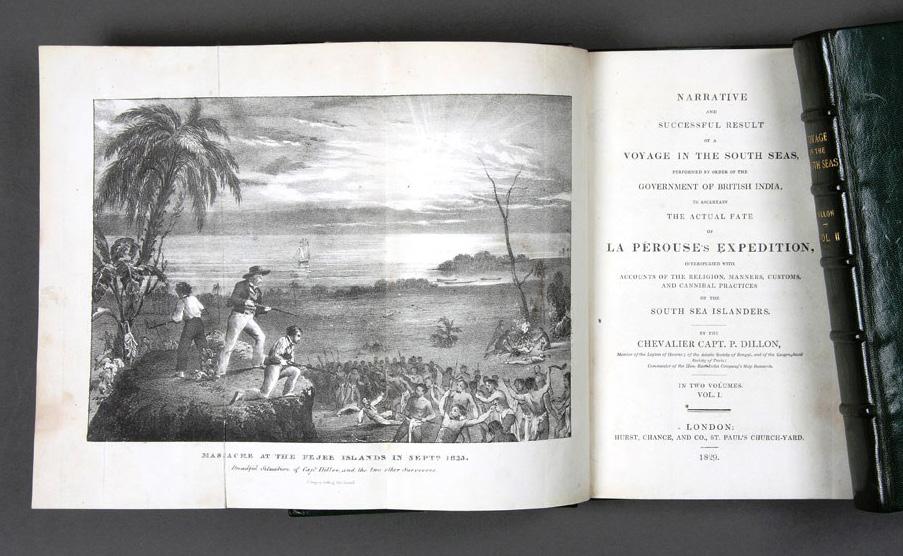
HOUSE hordern.com
HORDERN
Ferguson, 1255; Hill, 480; Hocken, p. 44; Kroepelien, 296; McLaren, ‘Lapérouse in the Pacific’, 71; Spence, ‘Bligh’, p.15.
IMPORTANT MAPPING OF THE PACIFIC FROM DUPERREY’S VOYAGE OF 1822-25
6. DUPERREY, Louis-Isidore.
Voyage autour du monde. Hydrographie Atlas.
Folio, with 49 maps (18 folding) and four plates of boats, crisp tall impressions; an excellent copy in old French quarter calf over papered boards. Paris, Arthus Bertrand, 1827.
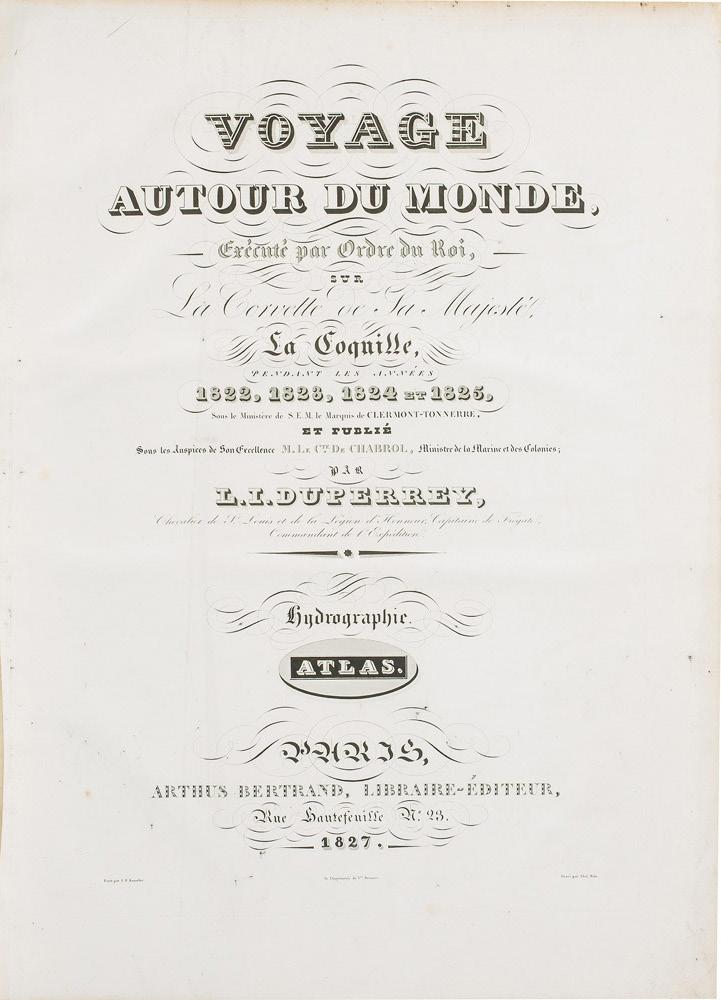
The complete hydrographical atlas from the Duperrey voyage, published as part of one of the immense French grands voyages series. As with most of these publications, the various components could also be bought separately, sometimes even being produced by different publishers. In fact full publication of the Duperrey voyage was never completed. His hydrographic work tended, as Dunmore comments, ‘towards perfecting existing maps rather than preparing charts of unknown areas’. As a result, the beautiful maps clearly display their debt to the earlier explorers, and include the discoveries and vessel tracks of luminaries such as Cook, Bougainville, La Pérouse, Bligh and Flinders.
Duperrey’s voyage gathered ‘vast quantities of ethnographic and scientific data’ (Hill), and included two visits to the Australian mainland. The details of the harbours at the Brisbane River and Macquarie Harbour in Nouvelle Hollande are attributed in the cartouche to Oxley and Evans respectively. The wonderful map of the Bay of Islands reflects the two weeks that the Duperrey expedition spent there in 1824.
Ferguson, 1069(n); Hill, 517; O’Reilly-Reitman, 822.
$16,500 [3804550 at hordern.com]
see description and illustrations at
HORDERN HOUSE hordern.com
FORSTER’S HOW-TO ON COLLECTING: A PRIMER FOR COOK’S SECOND VOYAGE
7. FORSTER, Johann Reinhold.
A Catalogue of the Animals of North America.
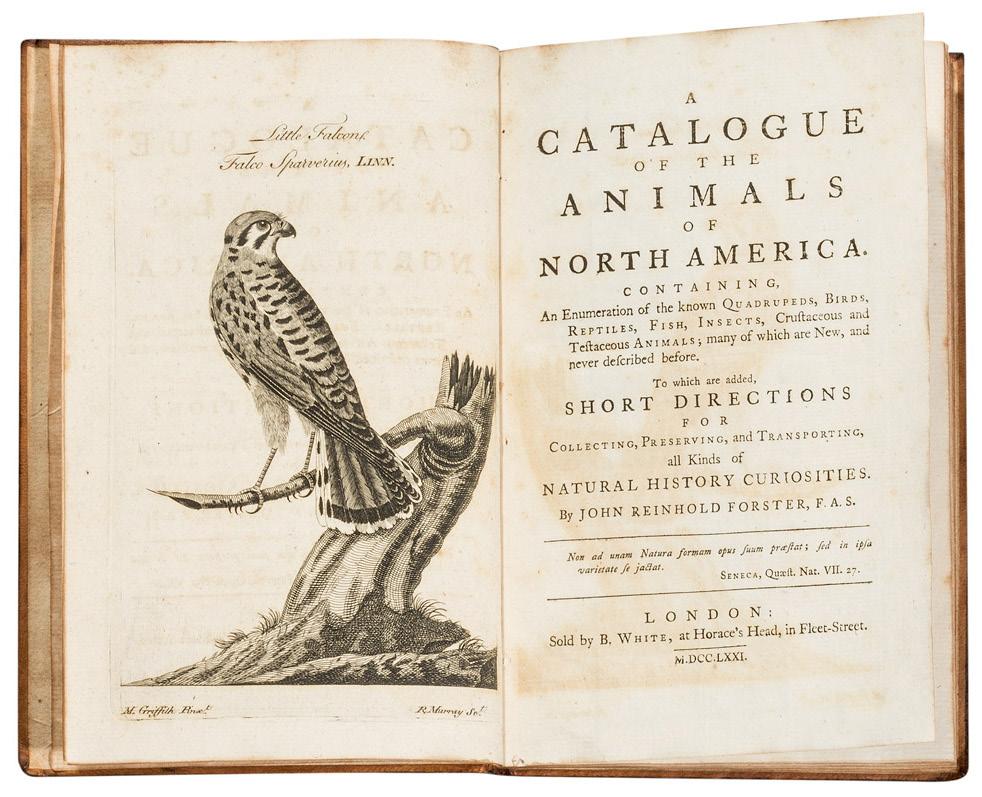
Octavo, with an engraved frontispiece; a delightful copy in its original binding of unlettered speckled sheep. London, B. White, 1771. First edition, and a rare early work by the German-born scientist most famous for sailing on Cook’s second voyage. (see item 2) Forster was a difficult man but a serious researcher, and this work represents his attempt to systematise the fragmented field of natural history studies from the Americas, largely based on specimens he had access to in British collections, particularly those of Joseph Banks (marked ‘B’) and Anna Blackburne (‘Mus. Bl,’). Averil Lysaght has pointed out that the Banks material derives from his important visit to Newfoundland and Labrador in 1766.
A pioneering study of North American natural history on the Linnaean model, the book has a fine frontispiece plate of a falcon by the natural history artist Moses Griffith. Coincidentally, and this is a good example of the concentric circles of interest and acquaintance that emanated from Joseph Banks’ house in Soho Square, Griffith was the artist privately retained by Pennant, and who had been commissioned the same year to paint the Rainbow Lorikeet collected on Cook’s Endeavour voyage that Banks had brought back to England (that painting is today in the National Library of Australia).
The work is, in effect, a manifesto for better collecting and more systematised recording of natural history from beyond the borders of Europe. The key point is that the book is designed in such a way as to encourage further work to be done, and perhaps the most significant section is Forster’s important note on collecting and preserving specimens, ‘Short Directions for Lovers and Promoters of Natural History.’ This substantial part (about half) of the book gives a fascinating overview of the best practice of the era, much in the vein of similar guides such as those of John Ellis (1770) and William Curtis (1771), but with the added interest of having been penned by Forster himself, who personally went on to make an enormous collection of artificial curiosities and natural history specimens in the Pacific. These directions give quite an insight into how Forster personally went about his work with Cook, with glimpses of various practices that he helped establish: specimens should be accompanied by detailed field notes, as well as ‘the name by which the animal goes in his country, or among the various tribes of Indian nations’.
The book is very scarce, with only three copies recorded since 1993. We have not traced a copy of this original edition in any Australian library, where it is represented only by microform copies and by the second edition of 1882 (edited by Philip Lutley Sclater for the Willughby Society, its publication an indication of the scarcity of the original edition even then).
$12,000 [4505068 at hordern.com] see description and illustrations at
HORDERN HOUSE hordern.com
Hoare (ed.), The Resolution Journal of Johann Reinhold Forster; Lysaght, ‘Joseph Banks in Newfoundland and Labrador, 1766’, 1971, p.251; NLA online catalogue; O’Reilly-Reitman, 2464; Pritzel, 2974 (journal publication only); Sabin, 25133.
THE LIMITED DE LUXE ISSUE
8. HAMILTON, George.
A Voyage Round the World in His Majesty’s Frigate Pandora.
Octavo, with five illustrations; full polished crimson calf, otherwise fine in green cloth folding case. Sydney, Hordern House, 1998.

One of 50 copies of the deluxe issue, bound in full polished calf, and signed by Peter Gesner. This is a faithful facsimile of A Voyage Round the World in His Majesty’s Frigate Pandora, the rare and important contemporary publication relating to Bligh and the mutiny on the Bounty. This publication, number four in the Australian Maritime Series and long out of print, reproduced the book for the first time since 1793, complete with the frontispiece portrait of Hamilton, with the addition of modern scholarship.
The story of the Pandora, the ship which was sent to recover the Bounty and to bring the mutineers to justice, rivals even that of Bligh’s mutiny on the Bounty for drama and tragedy. George Hamilton, with a light and humorous touch, not only brought to life conditions on board an eighteenth-century ship, he provided the vital clue that led modern-day archaeologists to the location of the deeply submerged wreck. On page 108 of the book Hamilton recorded - “A sandy key, four miles off, and about thirty paces long, afforded us a resting place” - and these words led a team of archaeologists in 1977 to select several coral outcrops as a primary search area within the Great Barrier Reef opening known as Pandora Entrance. The significance of this detail ensures that Hamilton’s Account will forever play a crucial role in one of the most important marine archaeological sites in the southern hemisphere.
As Peter Gesner, Curator of Marine Archaeology at the Queensland Museum and leading expert on the Pandora shipwreck, said, “There, below the reef, within touch, was an almost intact time capsule of the eighteenth century. I dived inside and it was a little like entering a room that had been undisturbed for 200 years”. The amazing story of surgeon George Hamilton and the Pandora voyage is thoroughly covered in Peter Gesner’s essay which accompanies this facsimile of Hamilton’s narrative.
$600 [4310617 at hordern.com] see description and illustrations at
HORDERN HOUSE hordern.com
9 [LA PEROUSE] SANQUIRICO, Alessandro, after, engraved by Carolina LOSE.
Esterno Di Una Capanna [The exterior of a Cabin]…
Aquatint with original hand colouring, 340 x 390 mm, mounted and handsomely framed. Milan, Autumn 1825. Atmospheric coloured aquatint depicting an evocative scene from the staging of the “BalletPantomime” based on the disappearance of La Pérouse in the Pacific. Between the complete disappearance of the expedition in 1788 and the discovery of relics in 1827, just a couple of years after this performance, the mystery had captivated Europe. (Famously Louis XVI is said to have repeated on his way to the scaffold the question that he had been asking for months: ‘‘Is there any news of M. de La Pérouse?”).

The disappearance inspired various highly imaginative performances or visualisations, and this scene was evidently one of the highlights from a very successful “pantomime” much performed in England and here being toured in northern Italy. As the caption notes the Naufragio was staged at the Teatrico Lirico in Milan (known as the Canobbiana until the 1890s). It starred the English actor William Barrymore (1759-1830). His European tour is not noted in the biography provided by the wonderful Garrick Club archives which mention his appearances in ‘musical pieces and comedies. He was also a leading actor at the Haymarket Theatre for many summer seasons. Critical reports describe him as an awkward performer, who acted with stiff knees, and had trouble retaining his lines; but at least one friendly source praised his judgment, noted his improvement over the years and suggested that he was industrious and steady as a second-rate actor. The last several years of his career he spent in the provinces…’.
The image dates from the high-water mark of early Italian opera, a period when innovations in set-design saw staging become a vital part of the art form. The staging was certainly dramatic with a hut apparently made from salvaged timbers at right in the shade of a rocky outcropping and several exotic plants.
This moody scene is by Alessandro Sanquirico a Milanese artist and stage-designer who was inspired to document the striking sets of the Milanese opera. It was engraved by Carolina Lose, née von Schlieben, who was well known for engraved topographical views of Italy produced in collaboration with her husband Federico. Sanquirico and the Lose pair collaborated on a number of Milanese theatrical subjects.
An extremely handsome image, one of the finest produced on the epic story of La Perouse: we have tracked down just one other example, in the Cia Fornaroli collection of the New York Public Library. not in Ferguson; not in Maclaren.
$7850 [4504990 at hordern.com] see description and illustrations at
HORDERN HOUSE hordern.com
SUPERB
EXPRESSION OF THE LA PEROUSE MYTH
AUSTRALIAN INSECTS COLLECTED BY BANKS AND LABILLARDIÈRE
10. OLIVIER, Guillaume Antoine and Pierre André LATREILLE.
Encyclopédie méthodique. Histoire naturelle: Insectes.
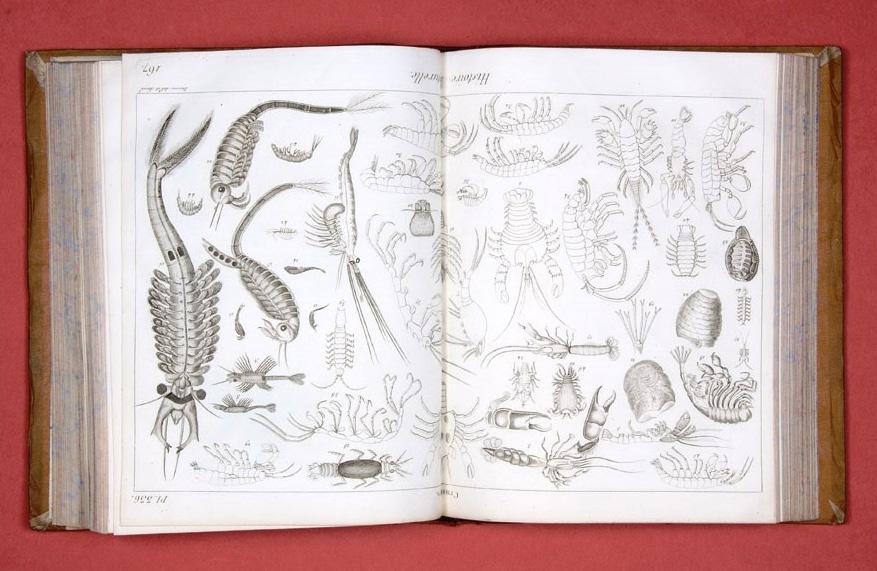
Nine quarto volumes, comprising seven text volumes and two volumes containing 397 engraved illustrations; in contemporary quarter roan with red labels. Paris, Panckoucke, Agasse, 1789-1825.
The first major comparative study to illustrate Australian insects. Published over a span of almost two decades, this is an important work of entomology. A product of the high enlightenment, the Insectes was originally included within the famous Encyclopédie méthodique and the breadth of the manifest learning is phenomenal, a testament to the spirit of the enlightenment.
Although the entomological works of John Lewin and Edward Donovan (both published 1805) have rightly been accorded iconic status in Australian natural history, this work by Olivier has not been given much attention despite the fact that the first four volumes date from the last decade of the eighteenth century. Scores of Australian insects are illustrated here for the first time – by our count at least 98 are firmly attributed to Australia or Van Diemens Land – most of them by comparison with the originals in the collection of Sir Joseph Banks. A selection of New Zealand bugs and others from Pacific islands also derives from the Banks collection.
Olivier built on the work of the scholars of his day, and was particularly reliant on the work of his contemporary Johann C. Fabricius, who printed the earliest textual description of any insects collected on the Endeavour voyage in 1775. Olivier’s brief but gracious advertisement in the first volume here suggests that the primary resources for this work were the collections of Linnaeus, the descriptions of Fabricius, and the entomological riches of London. First among equals in London, Olivier notes, is of course Banks, who personally made valuable collections during his voyages around the world with Captain Cook (“La riche collection d’insectes que ce célèbre naturaliste à rapportés de ses voyages autour du globe, avec le Capitaine Cook…”). Not only did Banks himself collect on the voyage, but his interest in insects made Soho Square the paramount collection in London over the succeeding decades, as his friends and colleagues vied for the chance to supply non-descript insects; this is neatly shown by the fact that of the bugs from all parts of the globe, literally hundreds are described from specimens in the Banks collection. Olivier is known to have visited London in 1789, when he visited Banks, but also got in touch with other English collectors including the President of the Linnean Society James Edward Smith, the nurseryman from Hammersmith James Lee, John Latham and Thomas Martyn.
Equally significantly, by the publication of the fifth volume (first issued in 1807) many of the new insects being added, including several more Australian specimens, are from the Labillardière collection, and must have been gathered by the famous French natural historian on the d’Entrecasteaux voyage.
B.M. (Nat. Hist.) II, 527.
$8850 [4103473 at hordern.com] see description and illustrations at
HORDERN HOUSE hordern.com
THE IDEAL IMAGE OF THE TAHITIAN AS “NOBLE SAVAGE”
11. [OMAI] DANCE, Nathaniel, engraved by F. BARTOLOZZI.
Omai, A Native of Ulaietea.
Etching and stipple engraving, 540 x 330 mm.; framed. London, Publish’d according to Act of Parlt., 25th October 1774. A wonderful full-length portrait of Omai (also known as “Mai”), the Tahitian who was seen as an outstanding example of Rousseau’s noble savage when he arrived in England on the Adventure with Captain Furneaux on the return to England of Cook’s second voyage in 1774. The portrait is based on the painting by Nathaniel Dance, who would later also paint Captain Cook. Omai is shown carrying the wooden pillowstool now in the Musée de Tahiti et des Iles. With a feathered circlet and draped in tapa cloth and with tattooed hands he embodies the beauty of the newly discovered Pacific islanders.
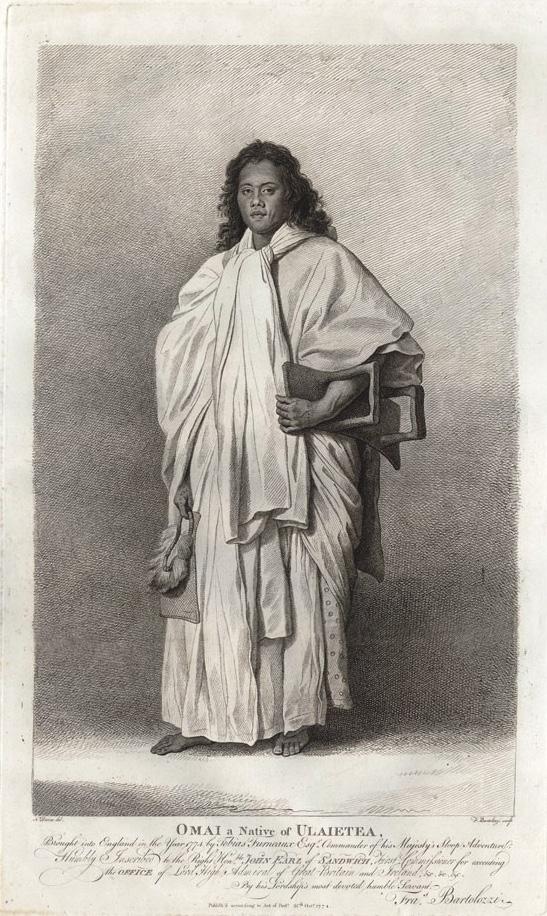
Dance’s portrait is the best known of the several images of the famous Tahitian, who was placed in the care of Joseph Banks and Dr Solander when he arrived in England, both of whom he remembered from their visit to Tahiti five years earlier on Cook’s first voyage. His natural grace captivated London society. This romantic portrait exemplifies the great contemporary interest in Omai: it was one of the first of the large-scale and separately-issued images produced to satisfy European curiosity and anthropological interest in the peoples of the Pacific. This tradition of taking exotic natives of interest back to Europe really took hold with the voyagers of the second half of the eighteenth century, most famously with Bougainville and Cook (though nearly a hundred years earlier Dampier had taken Giolo, the “Painted Prince”, back to England with him) and continued well into the nineteenth century.
The four-line inscription mentions both Furneaux and, particularly, Lord Sandwich of the Admiralty, who was Omai’s great friend and protector during his two-year stay in England.
Francesco Bartolozzi was renowned throughout Europe for his technique of “stippled” engravings, of which this is a fine example. Joseph Banks so admired Dance’s painting that he personally commissioned Bartolozzi to do the engraving. Bartolozzi was born in Florence in 1727 and after studying drawing moved to Venice specifically to pursue his interest in engraving. He arrived in London in 1764 and was quickly appointed “Engraver to the King”. Remaining in London for the next forty years Bartolozzi was a founding member of the Royal Academy from 1768.
Beddie, 4569; Nan Kivell and Spence, p. 238 (illustrated, p. 75).
$11,500 [3904130 at hordern.com] see description and illustrations at
HORDERN HOUSE hordern.com
FEATHER CLOAKS AND TAPA
12. [PORTLAND MUSEUM] SKINNER AND CO., Auctioneers.
A Catalogue of the Portland Museum…
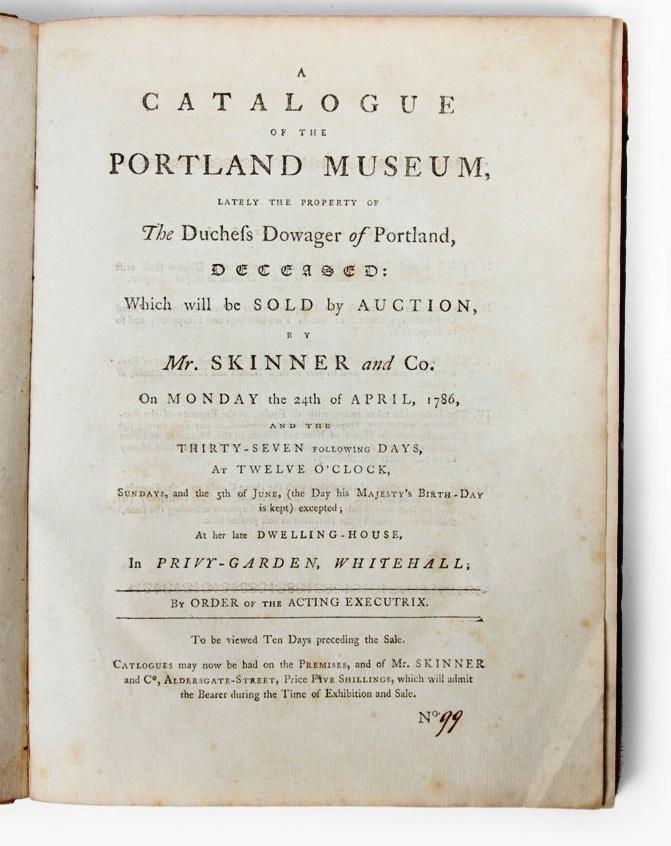
Quarto; engraved frontispiece not present (as is the case with some copies), contemporary half sheep. London, Skinner and Co., 1786.
An unsophisticated copy of this rare auction catalogue, of particular interest to Australia and the Pacific for its many hundreds of natural history lots, including the enormous and important collection of shells, catalogued for the auctioneer by Banks’s protégé Solander. Many of the specimens had been brought back on the Cook voyages from Australia, New Zealand and the Pacific. Great Tahitian and Hawaiian rarities, including large pieces of Tapa, feather cloaks and helmets, and the like, are listed and described in the catalogue.
This is the auction catalogue for the dispersal of the collection of natural history specimens gathered by Margaret Cavendish Bentwick, second Duchess of Portland, which was “considered the finest in England and rivalled the best in Europe” (Dance Shell Collecting, An Illustrated History). The Duchess was a patron of Captain Cook, friend of Rousseau and Reynolds, and a colleague of Daniel Solander. Through years of intrepid collecting her magnificent home, Bulstrode House in Buckinghamshire, became her museum.
Bulstrode or ‘The Hive’ as it was known is court circles, was a place of great activity, a place not only for the display of Margaret’s collection but where she and her team of botanists, entomologists and ornithologists worked. Scores of people would visit, from scholars, philosophers and scientists to Royalty. The Portland Museum was legendary; a place of delights where the ancient and the living were arranged side by side and where people came to be amazed at nature captured in its full diversity.
The catalogue was drawn up her chaplain and (long-time) librarian the Reverend John Lightfoot, with specialist assistance from others including Solander who described the cabinet of shells.
Chalmers-Hunt, ‘Natural History Auctions 1700-1972’, p. 62; Forbes, Hawaiian National Bibliography, 116.
$3850 [3403138 at hordern.com] see description and illustrations at
hordern.com
HORDERN HOUSE
HAWAIIAN
MIDSUMMER NIGHT’S DREAM IN THE MARQUESAS
13. SCHINZ, Heinrich Rudolf. BRODTMANN, K.J., lithographer and publisher.
[Lithograph of Tattooed Marquesans]…
Quarto, 405 x 315 mm visible, decoratively mounted and framed. Zurich, Brodtmann, 1824.
An amazing and large early lithographic image depicting two tattooed men of the Marquesan Islands of the South Pacific. This is the work of Heinrich Rudolf Schinz (1777-1861), a Swiss physician and naturalist, taken from his rare publication “Naturgeschichte und Abbildungen der Säugethiere”, a remarkable ethnographic survey of native inhabitants of the world that brought together descriptions and images of peoples of Kamtschatka, Japan, China, Timor, Hawaii, Tahiti, Australia, North America and Africa.
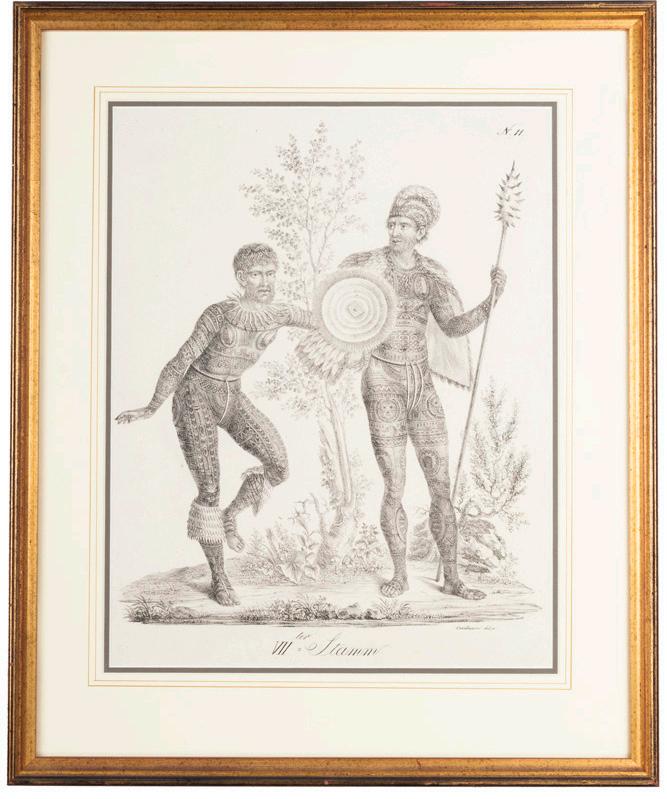
Schinz sourced his work from major voyage accounts including those of Cook, Langsdorff, Kotzebue, Krusenstern and Baudin. Sailors on these early voyages began to adopt tattooing on first seeing these incredibly decorated islanders; by so doing they introduced the art to the West.
Schinz’s images were first lithographed by Engelmann, the pioneer in the genre, and have been justly described as having a “Midsummer Night’s Dream” air to them, a feeling which is evidenced in this remarkable image prepared by Karl Joseph Brodtmann (1787-1862), the accomplished Swiss artist and lithographer working in Zurich.
Marquesan tattoos can be recognized by symbols, such as geckos, centipedes, the Marquesan Cross and other geometric designs, while the overall designs distinguish themselves through the use of symbols and artistic renderings of lines, arches and circles. Such features are uniquely attributed and linked through history to the South Pacific Islands. Every individual’s tattoos were different and signified heritage, accomplishments, the specific island the individual came from and their familial position. Boys received their first tattoos in their teens in a ritual setting and by older age often had tattoos all over their bodies as seen here.
Provenance: Private collection (New South Wales).
$4500 [5000582 at hordern.com] see description and illustrations at
HORDERN HOUSE hordern.com
THE SHELLS OF THE WORLD, CLASSIFIED AS PER LINNAEUS

14. [SHELLS] MAWE, John.
The Linnæan System of Conchology…
Octavo, with 37 lithograph plates, the first of which is the handcoloured frontispiece; a fine and large copy, completely uncut in the original binding of brown boards with printed label; 16 pp Longmans advertisements dated April 1826 at start and 2 pp Mawe’s own advertisements at the end. London, printed for and sold by the author… and Longman, Hurst, Rees, Orme, and Brown, 1823.
A fundamental and very well illustrated classification of shells of the world by one of the leading 19th-century shell experts, a major authority on the subject. Dedicated to the President and Fellows of the Linnæan [now Linnean] Society, the body founded by Sir James Edward Smith in 1788, Mawe’s book encompasses the shells of the world, many of them discoveries of the previous few decades by explorers and travellers. Mawe had been an acquirer of shells for many years, his most significant purchase having been the entire collection of William Bligh’s widow Elizabeth, “for a valuable consideration”, which he had offered at auction in the year preceding this publication, noting in the preface to the catalogue that “…To any voyager fond of this beautiful branch of Natural History, or to any collector resident on their shores, the South Seas offer a fine harvest; but the late Admiral Bligh had, from the situations in which his professional eminence placed him, the best opportunities of procuring whatever was most valuable and rare, from a field proverbially rich”. Mawe himself both studied and acquired from those same rich fields, his geographical sources cited in the present work ranging all over the world and including New Holland, New South Wales, New Zealand, the South Seas and other parts of the “new” world. Traveller, collector and conchologist, he also ran a flourishing business at 149 Strand. His advertisement that ends the book shows that as well as his own several publications he held a wide stock of minerals and associated apparatus, and of course shells. He offered “an extensive variety of the finest specimens” with “collections of shells for students, showing the Genera, at various prices from Three Guineas to Twenty”. Offered too were “secondary shells, a great variety” and finally the tempting “Inferior Shells for Grottoes”.
The beautifully drawn lithographic plates that illustrate the book were by E.A. Crouch: most authors fail to acknowledge their illustrators but Mawe flags in his Preface (p xii) that ‘The plates which embellish this work are taken from specimens in our own cabinet, and we are indebted to the kindness and indefatigable exertions of an artist of the greatest talent, for the accurate and elegant delineation of them’.
Mawe was an influential figure of his period. Briefly at one time a captain in the merchant marine, he became one of the loose grouping of individuals who cherished and competed for the finds made by the explorers.
Not known to Ferguson despite Australian content (an earlier work is listed as 397).
Provenance: Mary Walker (ink signature on endpaper).
$2850 [4505189 at hordern.com] see description and illustrations at
HORDERN HOUSE hordern.com
BY AN ARTIST FOR FLINDERS AND BLIGH
15. TOBIN, George (attributed).
Original watercolour of a British fleet of ships among icebergs.
Watercolour, oval shape, 132 x 195 mm., tipped on to card, in gilt frame.circa 1793-, 1797.
A finely executed watercolour of a fleet amidst icebergs. Although unsigned, this watercolour was originally found in a nineteenth century album with another of very similar style signed and dated by Tobin, an important amateur artist in the early history of Australia. Tobin was born in 1768 and joined the Navy as a lively lad in 1780. He showed natural aptitude and rose to the rank of lieutenant after an extended voyage for the East India Company between 1788-1790. He served with Flinders under Bligh on the Providence, the second voyage to Tahiti to gather breadfruit following the disastrous Bounty mutiny.
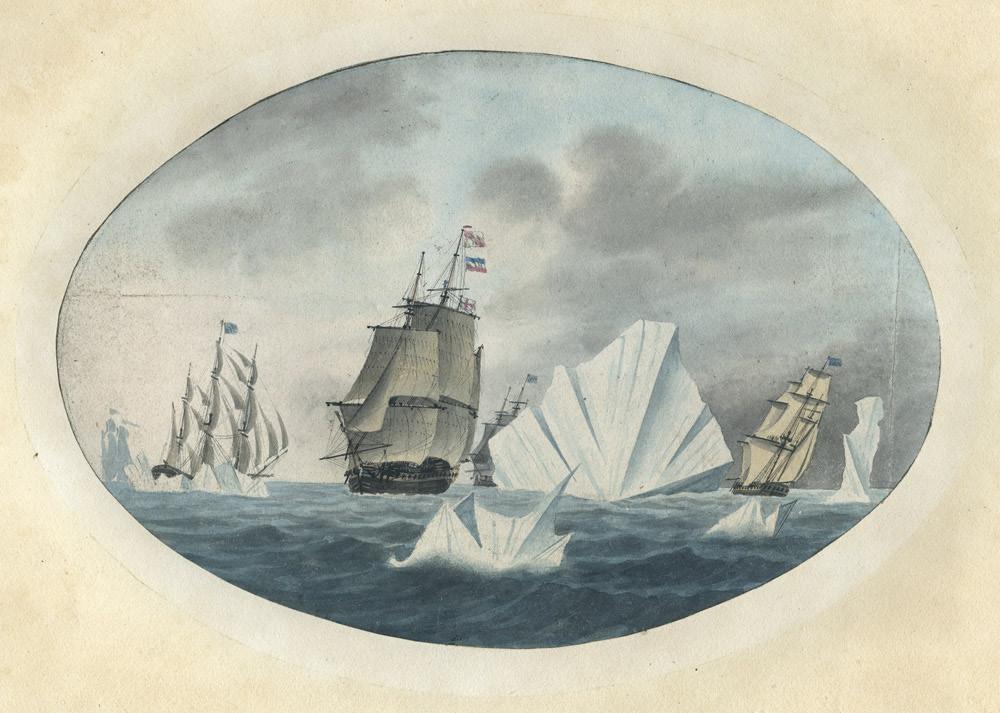
Tobin was a highly skilled watercolourist who kept a detailed record of the Providence voyage including paintings of Tasmanian scenes. On his return to England he served under Cochrane on the Thetis between 1793-1797 and continued to produce marine scenes in a more mature and conservative style than the watercolours undertaken in the Pacific. The Mitchell Library holds an important album of watercolours dating from his service on the Thetis. This study of ships amidst icebergs is strongly reminiscent of the marine studies in this album, characterised by the highly detailed treatment of rigging and naval architecture, accomplished treatment of sea, clouds and sky and the use of subdued and harmonious colouring.
This scene more than likely depicts British ships off Newfoundland in 1796. A much larger combined fleet of French and Spanish ships had been repelled by a smaller number of British ships in their attempt to disrupt the fishing industry on Newfoundland in 1796. The flag signal from the main mast of the ship is likely to state “In case of parting company either by accident or otherwise, without have orders where to go Repair to the rendezvous No 2”.
George Tobin was one of the most important and accomplished amateur artists in the early history of Australia and the opening of the Pacific: ‘His colouring was very good - bold and strong and sure. He had an accurate eye for perspective, a sensitive feeling for distance and for the movement of wind and water, and his general composition was almost always excellent’ (Rex and Thea Rienits, Early Artists of Australia).
Provenance: From a nineteenth century album of watercolours.
$8500 [4504759 at hordern.com] see description and illustrations at
HORDERN HOUSE hordern.com
HORDERN HOUSE hordern.com
EXOTICA OF THE NEW WORLD
16 VOYAGE IMAGES.
A decorated French textile…
Printed textile, 720 x 770 mm, mounted and attractively framed (externally 1000 x 1050 mm). France, circa 1830.
A desirable and imaginative piece of French block-printed textile dating from the Age of Discovery.
The design reflects the excitement for European spectators of the splendid eighteenth and early nineteenth-century voyages exploring new worlds. The discovery of exotic places and meetings with distant peoples, ships on voyages of discovery, and sea-battles, are woven together here encapsulating how the exploration of the Pacific and the Americas were seen.
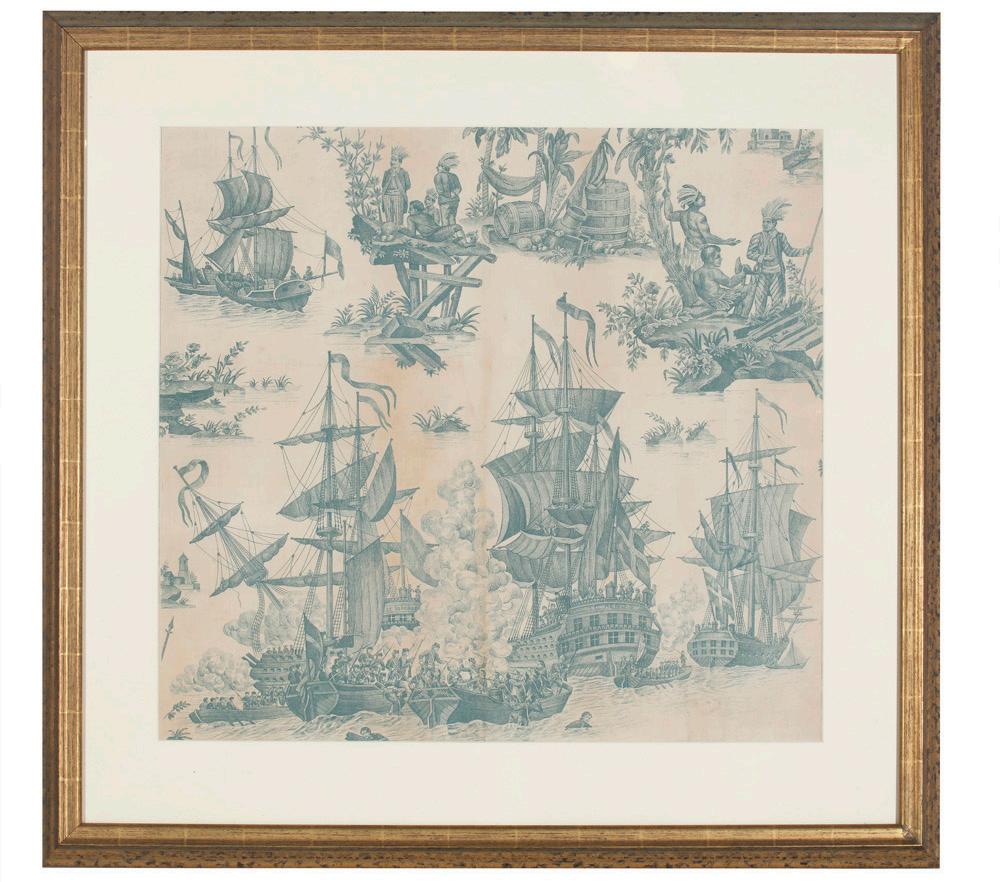
Provenance: From a New York private collection.
$3250 [5000822 at hordern.com] see description and illustrations at
PORTUGUESE VERSION OF WAHLEN’S COSTUMES
17. WAHLEN, Augusto.
Costumes usos e trajos de Todos os Povos do Mundo…
Thick octavo, 153 highly-finished handcoloured engravings; red blind-panelled morocco, all edges gilt. Lisbon, Imprensa Lusitana Typographia Lisbonense, 1872-, 1873.
Rare Portuguese edition of Wahlen’s Moeurs, Usages et Costumes de tous les peuples du monde… (Brussels, 1844), published well after Wahlen’s death in 1850. Wahlen’s is a scarce and beautiful work on the costumes of the world, finely illustrated with a wonderful series of highly coloured full-page plates. This Portuguese edition is not recorded by Ferguson, although there are 30 plates of Oceania; it includes the Aborigines of Jervis Bay and Kangaroo Isladssdnd, and the exotic peoples of Pitcairn Island, New Guinea, Timor, Java, New Zealand and Hawaii.
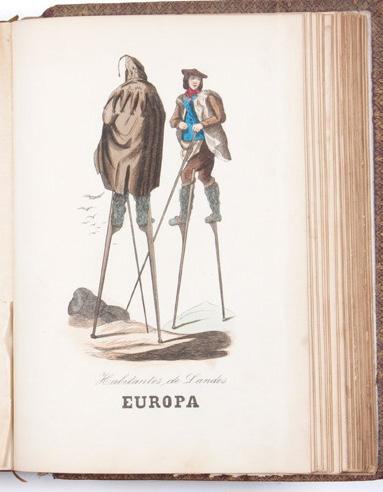
As with the earlier Brussels edition, the plates are drawn from published voyage accounts. The startling portraits of the Aborigines of Jervis Bay and Kangaroo Island are copied from De Sainson’s studies made on Dumont D’Urville’s voyage on the Astrolabe. Other images come from Krusenstern, while the Tahitian dancer is after John Webber from the account of Cook’s third voyage. Portrait profiles of Māori people are based on Sydney Parkinson’s images published in the official account of Cook’s first voyage, and a native of New Guinea is adapted from P. Van Oort’s “Native of Dourga Strait, New Guinea”, which appeared as the frontispiece to Earl’s The Native Races of the Indian Archipelago.

This is a volume of plates only, evidently part of a larger work (it is numbered volume 6 on the spine). The National Library’s copy has two volumes.
See Ferguson (Addenda), 3760a, 3761-3 (for the Brussels edition).
$2200 [2708049 at hordern.com] see description and illustrations at
HORDERN HOUSE hordern.com
FIRST AQUATINT ISSUE OF WEBBER’S TAHITIAN VIEW
18. WEBBER, John and Marie Catherina PRESTEL. A View in Matavai, Otaheite.
Aquatint in sepia tones on laid paper, 290 x 430 mm, full margins, mounted. London, J. Webber, No. 312 Oxford Street, 1787.
A very rare and separately issued early form of the View in Matavai, Otaheite prepared by the artists John Webber and Marie Catherine Prestel in 1787.
Issued in aquatint, a newly arrived technique, this is one of the most romantic and tropical scenes encountered during Cook’s voyage. The image had first been done as a line etching in November 1786, but Webber decided instead to experiment with the aquatint method in collaboration with Marie Catherine Prestel, ‘an aquatint artist of some note, who had recently come to London from Frankfurt’ (Joppien & Smith, p. 192). This is the first of two issues; a second appeared in 1788.

Webber found that this new method ‘allowed greater freedom and a wider range of evocative tones of light and shade’ (Joppien & Smith). He ultimately prepared four aquatints with Prestel, this being one of them: all are rare. It is a famous image; as Joppien and Smith note, ‘There can be no doubt that the drawing represents one of the most romantic and tropical scenes encountered during the voyage’.
$5850 [4208063 at hordern.com]
see description and illustrations at
HORDERN HOUSE hordern.com
Beddie, 1869 (examples of this issue in an album in the Dixson Library); Hill, 1836-7 (Webber’s published views); Joppien & Smith, 3.120Ac.





















